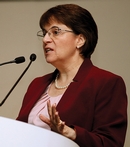
Aberle

McCollough
Advances in CT, including the use of low-dose CT and its use in the early detection and characterization of lung cancer, are having a substantial impact on routine clinical practice and remain an important topic of research, according to speakers at Tuesday's RSNA/American Association of Physicists (AAPM) symposium, "State of the Art in CT Imaging."
"Within the last five years, there have been numerous changes in CT imaging, including physics and clinical developments related to dose, new classes of iterative CT image reconstruction algorithms and new lung nodule classification rules," said Paul E. Kinahan, PhD, symposium moderator, vice chair for radiology research and head of the imaging research laboratory, University of Washington, Seattle.
Image Quality Remains the Goal as CT Dose Lowers
During her presentation, "CT Technology - and Dose - in the 21st Century," Cynthia H. McCollough, PhD, president-elect of AAPM and a professor of biomedical engineering and medical physics at Mayo Clinic College of Medicine and Science, Rochester, MN, reviewed the unique challenges and changes within CT over the years and discussed important current considerations, especially regarding the use of low-dose CT.
"With all the advances in CT over the last decade, including changes in scanner design, dual-energy CT and widespread adoption of iterative reconstruction and noise reduction techniques, body CT doses have fallen by over a factor of three since the early 80s," Dr. McCollough said. "It is important to remember though that as doses fall lower and lower, we don't want to inadvertently drive the clinical image quality lower too."
Additional emerging technologies, such as deep learning and photon-counting detector CT, will continue to drive the expansion that has already taken place in the early part of this century, according to Dr. McCollough.
"Dose customization that is specific to the patient and to the reason for the exam as well as technical advances such as tube current modulation and tube potential optimization have the ability to ensure that patients get a quality CT exam at lower doses," she concluded.
Evolving Technology Allows New Approaches to Lung Cancer
During her presentation, "Contemporary CT of the Indeterminate Lung Nodule: Where We Are and Why it Matters," Denise R. Aberle, MD, professor of radiology and bioengineering at the University of California Los Angeles (UCLA) and vice chair for research in the Department of Radiological Sciences in the David Geffen School of Medicine at UCLA, discussed the current role of low-dose CT in lung cancer screening and early detection, including current approaches to the classification of indeterminate lung nodules.
Given the prominent role of semantic features in current diagnostic classification models of lung cancer, Dr. Aberle described approaches to standardizing semantic characterization of lung nodules based on an illustrated lexicon.
"The use of these more standard semantic features will play a role in training convolutional neural networks (CNN) to make output more interpretable to humans for lung nodule detection," Dr. Aberle said.
The benefits of this ever-changing landscape of CT and its diagnostic uses are pushing the boundaries of technology and customization.
"The greatest gains in CT may be multiparametric approaches," Dr. Aberle said. "Combining clinical, imaging and molecular features to complement the data and assist in its interpretation."

